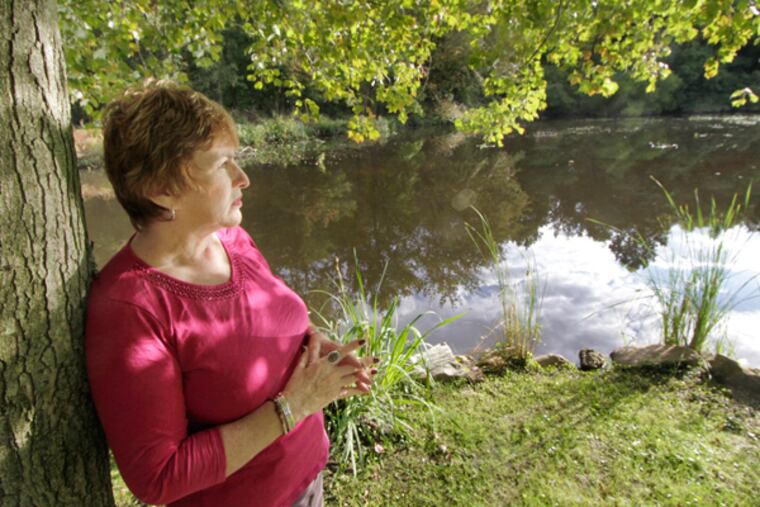In Camden County, impatience over lake's slow cleanup
In recent years, neighbors of Camden County's Kirkwood Lake looked on with growing concern as the lake bed became shallower and shallower and virulent vegetation took over large parts of the water's surface.

In recent years, neighbors of Camden County's Kirkwood Lake looked on with growing concern as the lake bed became shallower and shallower and virulent vegetation took over large parts of the water's surface.
To many residents, dredging the lake seemed the answer, but that was not to be. The county-owned lake, bordered by Voorhees and Lindenwold, is part of a federal Superfund site cluster - several miles of land and waterways allegedly contaminated by former paint manufacturers that operated in the area from the mid-1800s to the late 1970s.
A major cleanup is intended, with paint maker Sherwin-Williams cooperating with the U.S. Environmental Protection Agency and providing funding. But because of testing, studies, and Kirkwood's situation near the downstream end of the contaminated areas, lake remediation appeared to be years away, according to the EPA, possibly many years away.
"Something has to happen to effect a change. It keeps dragging on and on and on," Alice Johnston of Voorhees said over the summer, a year after she started the activist Kirkwood Lake Environmental Committee. "We have a lake that's dying."
But perhaps not.
A group of engineers connected to Rutgers University has proposed an alternative to dredging that they say could make the lake deeper, get rid of its arsenic- and lead-contaminated sediment, and that could be done much sooner than the EPA appears to be suggesting.
The process, proposed by engineers working with Rutgers' Center for Advanced Infrastructure and Transportation (CAIT), is called in situ stabilization. A cementlike material is introduced into the layer of contaminated sediment, containing it. In Kirkwood's case, it would be likely be removed, creating more depth.
"What we propose is to do a pilot project for Kirkwood," said Ali Maher, CAIT's director.
He said there was no cost estimate yet; that would depend on the size of the pilot program. But the engineers said they believed their method would be cheaper and more efficient than traditional dredging, which, according to the Camden County Municipal Utilities Authority, would probably cost more than $3 million.
"There's a tremendous amount of data that shows solidification and stabilization work," Maher said.
The idea has attracted interest from county officials such as Freeholder Jeffrey Nash, who has been working with neighbors of the lake, and U.S. Rep. Robert Andrews (D., N.J.), who has been talking to the EPA and Sherwin-Williams.
"I'm doing everything I can to reduce the timeline," Andrews said. He called the EPA's time estimates "just ridiculous."
Ray Klimcsak, the EPA's project manager, estimated last week that the beginning of cleanup activities was still about three years away in the upstream source area of the contamination.
Klimcsak said he was willing to consider the engineers' proposal. But he said he did not believe it would prevent the lake from recontamination by the even higher concentrations upstream.
At a public presentation last week, members of the Rutgers CAIT team said they believed measures such as sediment traps or weirs could prevent recontamination.
Sherwin-Williams spokesman Mike Conway said his company was "always open to exploring additional ideas regarding remediation opportunities and solutions."
Despite the lack of consensus, Nash said he was cautiously optimistic. "I think for the first time we are making headway," he said. "It's still frustrating."
The cleanup saga of the Sherwin-Williams site goes back more than three decades, with contamination found on land and waterways in Gibbsboro, where the plant was, into Voorhees.
Case records mention seepage found to contain contaminants being discovered in 1983 on the opposite side of the cleanup area. For many years, the N.J. Department of Environmental Protection oversaw the enforcement effort, but it ceded control to the EPA in 2001, according to the federal agency. Parts of the area are fenced off for public safety.
Alice Johnson, whose backyard is on the lake, has a 2000 letter from the EPA referring to contaminants in her soil, including lead, and advising precautions that included wearing gloves while gardening and making sure children don't put the soil in their mouths. By then, she had already raised her children there.
EPA officials now say there was no imminent health hazard from contaminants in soil and sediment in or around the lake.
Johnston is not so sure.
"My concern is the contaminants in the sediment that keeps overflowing into our backyard," she said.
Maybe because they have lived with knowledge of the contaminants for so long, most neighbors of Kirkwood express more concern about the survival of their lake, the water-lily-like spatterdocks that have been choking it in recent years, and what they see as the EPA's slow pace.
"Hell, it could be 10, 15 years before they remediate it," resident Ed Kelleher said. "I don't know what side of the grass I'll be on. I would just like to fish with my grandson and be able to put a line out."
At various times over the summer, boaters could not use part of the lake because of the thick spatterdock growth, and anglers could barely cast a line. Johnston said ducks were avoiding the lake; with the water so shallow, snapping turtles had an easy time nabbing a duckling lunch. Later in the summer, the county had pesticide applied to the growth. Parts of the lake improved, but the vegetation started growing back, Johnston said.
Johnston and her fellow residents now hope their elected officials can get Sherwin-Williams and the EPA to try the Rutgers program and that it works while they still have a lake.
Said Johnston: "We've never gotten this far before."